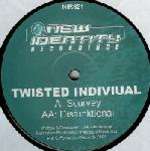Twisted Individual - Scurvey / Disfunktional - New Identity Recordings - Drum & Bass
 |
Price | £6.00 |
Track ListingA ScurveyAA Disfunktional Media Condition » Near Mint (NM or M-) Sleeve Condition » Near Mint (NM or M-) |
| Artist | Twisted Individual | ||
| Title | Scurvey / Disfunktional | ||
| Label | New Identity Recordings | ||
| Catalogue | NIR 021 | ||
| Format | Vinyl 12 Inch | ||
| Released | 2001 | ||
| Genre | Drum & Bass |
Other Titles by Twisted Individual
• The F Word / Swab Test • A Decade Of Breaks Part 1 • February • November • The Cannibal Lunch EP • The F Word / Swab Test • Vegetarian Meat Mash / Custard • April • Bandwagon Blues / Does Exactly What It Says On The Tin Or Your Money Back • Hand Grenade / Amen Slag (Remixes) • Soiled Snatch / Rusty Sheriff's Badge • Soiled Snatch / Rusty Sheriff's Badge • Sore Throat / Cyborg • Tooled Up LP Sampler • Tooled Up! •
Some Other Artists in the Drum & Bass Genre• Unknown Artist • Total Science • Mampi Swift • Goldie • Roni Size • Pascal • Drumsound & Simon • Digital • Spring Heel Jack • Tommy Knocker • Roni Size / Reprazent • Adam F • Moving Fusion • Distorted Minds • DJ Sappo • A-Sides • Jonny L • Flytronix • Danny C • John B • King Kooba • JB • Ray Keith • Clipz • Calyx • Chris K & Liquidedge • Missing • Lemon D • Drumsound & Simon Bassline Smith • Ultra Living • DJ SS • Alex Reece • Pressure Drop • The Underwolves • Majistrate • Facs • Peshay • Fresh • DJ Rap • D Product • |
Some Other Artists on the New Identity Recordings Label• Distorted Minds • Blue Sonix • DJ SS • Allude 8 • John B • Chino • Influx UK • Matrix • Influx UK & Electrosoul System • |
Information on the Drum & Bass Genre
Drum and bass (commonly abbreviated to D&B or DnB) is a type of electronic dance music which emerged in the mid 1990s. The genre is characterized by fast breakbeats (typically between 160–190 bpm, occasional variation is noted in older compositions), with heavy bass, sub-bass lines, and occasional infra-bass lines. Drum and bass began as an offshoot of the United Kingdom rave scene of the very early 1990s. Over the first decade of its existence, the incorporation of elements from various musical genres led to many permutations in its overall style.In the late 1980s and early 1990s, a growing nightclub culture gave birth to a new electronic music style called Rave music, which combined regular beats alongside broken, syncopated beats, strong basslines and a faster tempo than that of house music. By 1991, musical tracks made up of only "broken" beats began to be known as "jungle", branching off into a separate musical genre (circa 1991-1992) popular at raves and on pirate radio in urban Britain.
These tracks often combined ragga vocal tracks with broken beats and bass lines. By 1994 jungle began to gain mainstream popularity and fans of the music (known as junglists) became a recognizable part of British youth subculture. After being further developed, the sound took on a very urban, raggamuffin sound, incorporating dancehall ragga-style MC chants, dub basslines, but also increasingly complex, high tempo rapid fire breakbeat percussion. At this time jungle began to be associated with criminals and criminal activity and perhaps as a reaction or perhaps independently of this, producers began to draw away from the ragga style and create what they labeled drum and bass. There is no clear point at which jungle became drum and bass, though most jungle producers continue to produce what they call drum and bass.
As the music style became more polished and sophisticated, it began to shift from pirate to commercial radio and gain widespread acceptance (circa 1995-1997). It also began to split into recognizable subgenres such as jump-up. As a lighter sound of drum and bass began to win over the musical mainstream, many producers continued to work on the other end of the spectrum. This resulted in a series of releases offering a dark, technical sound which drew more influence from techno music and the soundscapes of science fiction and anime films, this subgenre became known as techstep (circa 1997-1998).
Towards the turn of the millennium, the UK garage sound emerged and quickly eclipsed drum and bass in popularity. Drawing a key part of its inspiration from drum and bass, it was commonly believed that UK garage was a replacement of the genre and statements were made to the effect that "drum and bass is dead". However, consistent development of the genre proved otherwise. The appearance of the liquid funk and other subgenres brought a wave of new artists with new ideas and techniques, supporting continual evolution of the genre. Drum and bass is perhaps not well-known as a genre, but makes frequent, unrecognized appearances in the mainstream such as in television commercials, as well as being a major influence for other musical styles and some of its artists (notably Goldie).
Data from the Discogs music database. Submit a Release.

